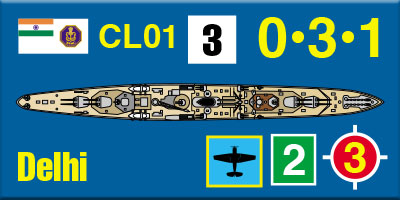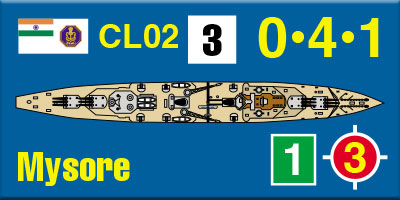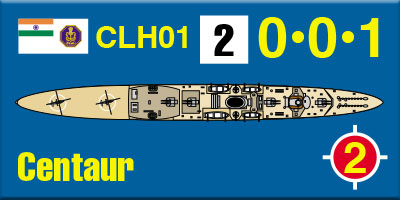Sword of the Sea:
The Royal Indian Navy, Part Two
by Mike Bennighof, Ph.D.
March 2023
 In the world of the Second Great War, naval armaments are under far lesser restrictions than was the case in our own reality. Every great power can build new battleships, though a limited number of them within restrictions on size and armament, and they can also retain and rebuild their older ships. That makes for larger fleets (thus fulfilling the purpose of the Second Great War at Sea alternative history, to allow for more and larger surface battles). In the world of the Second Great War, naval armaments are under far lesser restrictions than was the case in our own reality. Every great power can build new battleships, though a limited number of them within restrictions on size and armament, and they can also retain and rebuild their older ships. That makes for larger fleets (thus fulfilling the purpose of the Second Great War at Sea alternative history, to allow for more and larger surface battles).
The Royal Indian Navy existed in our own history, but operated small warships during the Second World War – escorts and minesweepers. In Second Great War at Sea: Sword of the Sea, we introduce the Royal Indian Navy, and its small fleet of battleships, cruisers and destroyers – a much larger force than it fielded in our own world.
But larger fleets require more sailors, and in our alternative history that need has led the Royal Navy to foster a much larger and more capable Royal Indian Navy than was the case in our actual history. India could provide skilled manpower, but at the cost of potentially adding even more fuel to the independence movement. Recruiting more Indian personnel would require selecting and training more Indian officers.
Expanding the training establishment occupied much of the Royal Indian Navy’s energies in the late 1930’s, even as more warships entered service. In case of war, the Indian-manned ships (with a large proportion of their officers and senior ratings still coming from the Royal Navy) would have the task of confronting the Ottoman Turkish squadron in the Red Sea, scouring the Indian Ocean for enemy commerce raiders, and maintaining access to the Suez Canal. To accomplish those missions, the Royal Indian Navy of 1941 (when the British Empire enters the Second Great War) fields a mixture of refurbished Royal Navy castoffs and newly-built warships. We looked at the capital ships in our first installment; let’s see the rest of them.
Cruisers
The Royal Indian Navy possesses a pair of modern light cruisers, built in Britain as part of larger classes. Delhi is a Leander-class ship, laid down in 1933 at Devonport Naval Dockyard as part of the second group of cruisers built to this design (all of which went to the Imperial navies). The Leander-class ships were designed to keep costs down, to allow the Royal Navy to purchase a large number of them to meet its requirements for commerce protection and other world-wide duties.

Delhi displaces 7,200 tons, with next to no armor beyond light splinter protection. She carries eight six-inch guns in four twin gunhouses, plus anti-aircraft weaponry and eight torpedo tubes. Her top turn of speed, 32 knots, is middling for a cruiser of this era.
Mysore is a more potent ship, a Fiji-class light cruiser commissioned just before the start of the war. She’s a bigger ship, displacing 8,500 tons, and carries a dozen six-inch guns in four triple turrets (rather than unarmored gunhouses like Delhi) plus six torpedo tubes and a stronger anti-aircraft suite than the smaller cruiser. She’s slightly slower than Delhi, at 31.5 knots top speed, but actually has an armored belt (though rather thin).

Note: These are the two cruisers purchased by the actual Indian Navy after the war (the former Achilles and Nigeria, respectively); this gives us a chance to introduce them to Second World War at Sea. Delhi would be de-commissioned in 1978 and Mysore in 1985.
Helicopter Cruisers
In the world of Wilson’s Peace, the end of the war two years before it did in our own history means that not only were millions of lives spared, but the warships of the contending powers suffered far less wear and tear. Vessels not worth keeping in our reality remain viable ships, though in some cases badly outdated.
The first warships donated to the Royal Indian Navy, the light cruisers Centaur and Concord, had been built with materials assembled for a pair of Ottoman Turkish cruisers ordered from the Vickers combine before the Great War. Otherwise, the followed the standard design for C-class light cruisers, small cruisers (3,7000 tons’ displacement) armed with five six-inch guns in shielded mounts and a pair of torpedo tubes. They had a top speed when new of 28 knots, with three inches of belt armor and thin covering on the armored deck.

By the mid-1930’s they had lost some of that already-moderate speed, and were no match for other nations’ modern cruisers. They had been very valuable in their training mission, as the Royal Indian Navy worked hard to turn its recruits into seamen. But the decision by the Baldwin government to modernize all useful warships applied to India as well, as the two old cruisers went to Bombay Dockyard in 1935.
The after decks were cut down to the main deck level, and replaced with a helicopter pad with two spots for landing and take-off, and a hangar capable of handling six machines. Plus workshops, with fuel and armaments stowage and crew quarters for the aviation detachment under the landing pad. The ships re-commissioned in 1938 and initially operated C.30 autogyros, switching to Hoverfly helicopters in early 1941. Their lack of speed and small size make the two cruisers more useful as convoy escorts than units of the battle fleet.
Note: The conversion’s based on that of the light cruiser HMS Tiger in the late 1960’s and early 1970’s, which produced a profoundly ugly ship that lasted but six years in service. Tiger was a much larger ship than Centaur, but she operated much larger helicopters and did not give over as much of her deck to flight operations as these conversions.
Destroyers
Completing the Royal Indian Navy’s squadron in Sword of the Sea are five big Tribal-class destroyers, a design maximized for surface combat with four twin 4.7-inch guns and four torpedo tubes.
Though designed to face the big new destroyers commissioning for the Japanese, German and Italian fleets, the Tribal class were (like all British destroyer designs of the period) not as large as their foreign counterparts. The boats weighed in at 1,800 tons’ displacement, but they could make 36 knots which still fell short of some of the newest foreign destroyers.

Despite those shortcomings, they remained impressive fighting units and saw hard and successful service in the actual Second World War. In the Second Great War era, surface combat is seen as more important than anti-air or anti-submarine warfare, and the Tribal class is even more prevalent than the 27 units built in our actual history.
The five Royal Indian Navy boats that appear in Sword of the Sea were all built in British yards. Another three boats (to complete a flotilla of eight) are under construction in Indian yards.
And that’s the Royal Indian Navy of Sword of the Sea.
You can order Sword of the Sea right here.
Sign up for our newsletter right here. Your info will never be sold or transferred; we'll just use it to update you on new games and new offers.
Mike Bennighof is president of Avalanche Press and holds a doctorate in history from Emory University. A Fulbright Scholar and NASA Journalist in Space finalist, he has published a great many books, games and articles on historical subjects; people are saying that some of them are actually good.
He lives in Birmingham, Alabama with his wife, three children, and new puppy. He misses his lizard-hunting Iron Dog, Leopold.
Want to keep Daily Content free of third-party ads? You can send us some love (and cash) through this link right here.
|
